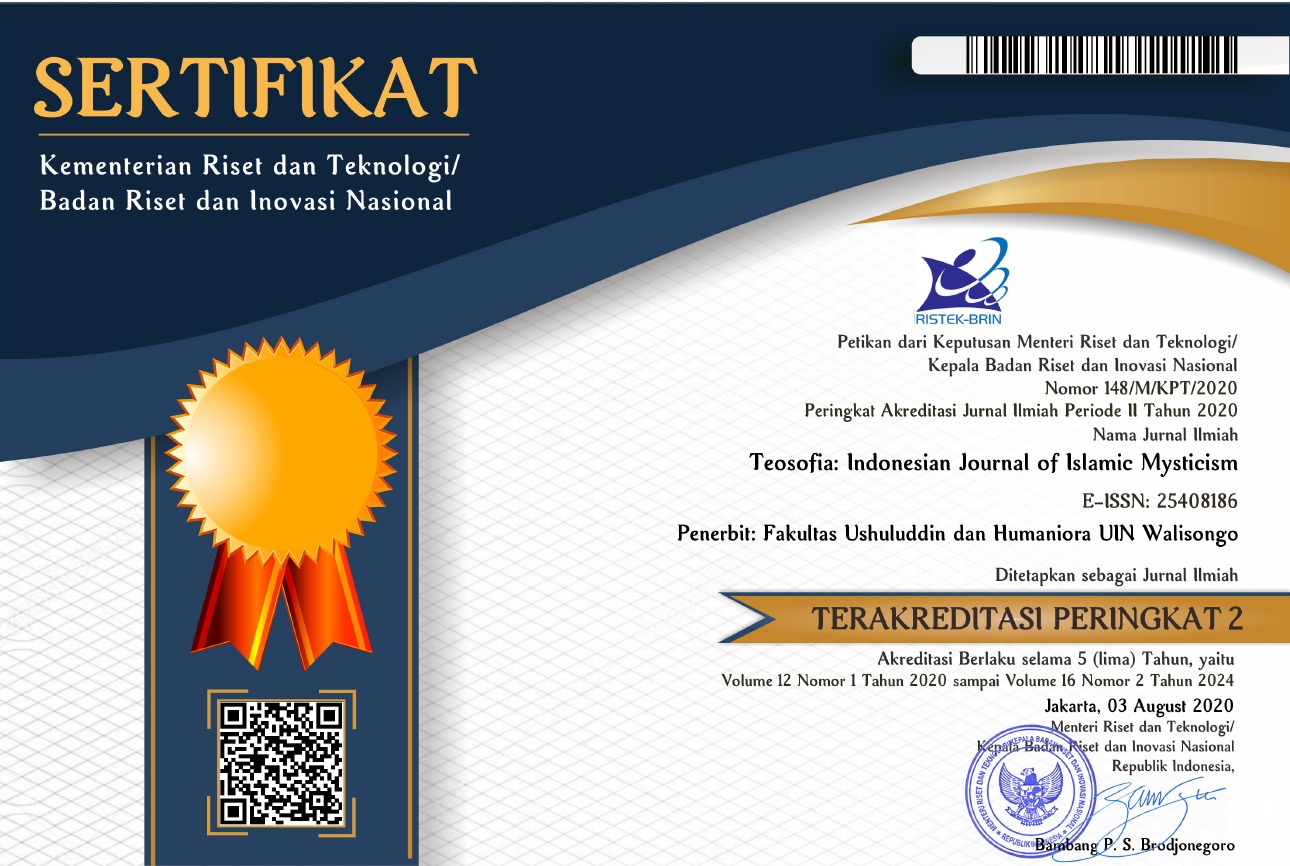“Will I Die Now?” Mystical Experiences in Individuals with COVID-19 after a Near-Death Experience
DOI:
https://doi.org/10.21580/tos.v12i1.16810Keywords:
near-death experience (NDE), mystical experience, COVID-19, consciousnessAbstract
Near-death experiences (NDEs) are closely related to emotional and spiritual dimensions, even though they are subjective. This study aims to reveal the mystical experiences of individuals suffering from COVID-19 after NDEs. This article is qualitative research with a phenomenological approach. With purposive sampling, the data were collected from individuals suffering from COVID-19 who experienced NDEs but recovered. The data were then analysed with interpretive phenomenological analysis (IPA). This study reveals that when individuals experience NDEs, they no longer see and feel their physical body but their spirit or soul. They also have mystical experiences, such as being visited and communicating with specific religious figures and even the spirits of people who had died. After NDEs, a comprehensive reconstruction occurs regarding their personal beliefs and values regarding life and death, especially their relationship with God.
Contribution: This study contributes to revealing the mystical experience of people after near-death experience (NDE). This study can be a recommendation, counselling, therapy and various psychological and religious interventions for individuals who experience NDE to accept their death more easily.
Downloads
References
Agrillo, Christian. “Near-Death Experience: Out-of-Body and Out-of-Brain?” Review of General Psychology 15, no. 1 (2011): 1–10. https://doi.org/10.1037/a0021992.
Bassett, Jonathan F., and Mel L. Bussard. “Examining the Complex Relation Among Religion, Morality, and Death Anxiety: Religion Can Be a Source of Comfort and Concern Regarding Fears of Death.” Omega (United States) 82, no. 3 (2021): 467–87. https://doi.org/10.1177/0030222818819343.
Hertz, Robert. Death and the Right Hand. Routledge, 2013. https://doi.org/10.4324/9781315017600.
Himawanti, Izza, Imam Faisal Hamzah, and Muhammad Faiq. “Finding God’s Way: Spiritual Well-Being on the People Who Do Tirakat Mlaku.” Teosofia: Indonesian Journal of Islamic Mysticism 11, no. 1 (2022): 43–62. https://doi.org/10.21580/tos.v11i1.10721.
Kli, Maria. “Eros and Thanatos: A Nondualistic Interpretation: The Dynamic of Drives in Personal and Civilizational Development from Freud to Marcuse.” Psychoanalytic Review 105, no. 1 (2018): 67–89. https://doi.org/10.1521/prev.2018.105.1.67.
Krause, Neal, and Peter C. Hill. “Assessing the Relationships Among Forgiveness by God, God Images, and Death Anxiety.” Omega (United States) 81, no. 3 (2020): 356–69. https://doi.org/10.1177/0030222818777376.
Martial, Charlotte, Héléna Cassol, Steven Laureys, and Olivia Gosseries. “Near-Death Experience as a Probe to Explore (Disconnected) Consciousness.” Trends in Cognitive Sciences 24, no. 3 (2020): 173–83. https://doi.org/10.1016/j.tics.2019.12.010.
Molnar, Michael. “Sigmund Freud ( 1856-1939 ): Life and Work,” 1996, 236–43.
Purwoko, Saktiyono B. Psikologi Islami Teori Dan Penelitian. Bandung: Blurb, 2012.
Rababa, Mohammad, Audai A. Hayajneh, and Wegdan Bani-Iss. “Association of Death Anxiety with Spiritual Well-Being and Religious Coping in Older Adults During the COVID-19 Pandemic.” Journal of Religion and Health 60, no. 1 (2021): 50–63. https://doi.org/10.1007/s10943-020-01129-x.
Reza, Syah. “Konsep Nafs Menurut Ibnu Sina.” KALIMAH 12, no. 2 (September 15, 2014): 263–80. https://doi.org/10.21111/klm.v12i2.239.
Ring, K., and S. Franklin. “Do Suicide Survivors Report Near-Death Experiences?” Omega 12, no. 3 (1981): 191–208. https://doi.org/10.2190/47XB-EGMR-9WKP-H3BX.
Royse, David, and Karen Badger. “Burn Survivors’ Near-Death Experiences: A Qualitative Examination.” Omega (United States) 80, no. 3 (2020): 440–57. https://doi.org/10.1177/0030222818755286.
Shklar, Judith N. “The Phenomenology.” Western Political Quarterly 27, no. 4 (1974): 597–623. https://doi.org/10.1177/106591297402700404.
Su’udi, Achmad. Bersama Allah Meraih Takdir Baik. Jakarta: QultumMedia, 2009.
Testoni, Ines, Dorella Ancona, and Lucia Ronconi. “The Ontological Representation of Death: A Scale to Measure the Idea of Annihilation versus Passage.” Omega (United States) 71, no. 1 (2015): 60–81. https://doi.org/10.1177/0030222814568289.
Upenieks, Laura. “Uncertainty in Faith , Fear of Death ? Transitions in Religious Doubt and Death Anxiety in Later Life,” 2021. https://doi.org/10.1177/00302228211029475.
Downloads
Published
How to Cite
Issue
Section
License
Copyright
The copyright of the received article shall be assigned to the journal as the publisher of the journal. The intended copyright includes the right to publish the article in various forms (including reprints). The journal maintains the publishing rights to the published articles. Therefore, the author must submit a statement of the Copyright Transfer Agreement.*)
Licensing

This work is licensed under a Creative Commons Attribution-ShareAlike 4.0 International License.
In line with the license, authors are allowed to share and adapt the material. In addition, the material must be given appropriate credit, provided with a link to the license, and indicated if changes were made. If authors remix, transform or build upon the material, authors must distribute their contributions under the same license as the original.
_______
*) Authors whose articles are accepted for publication will receive confirmation via email and send a Copyright Transfer Agreement.








